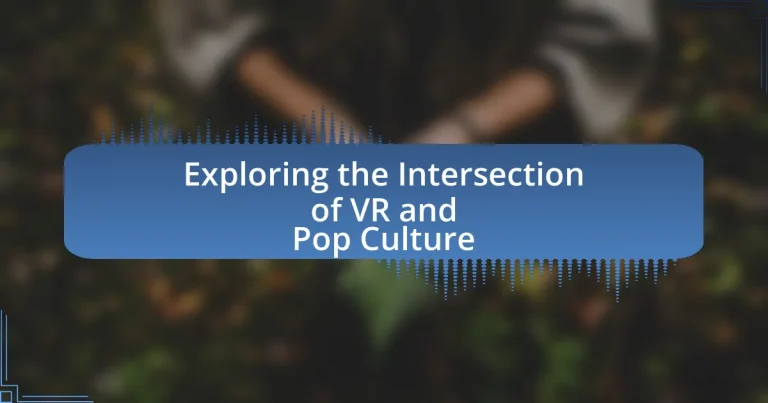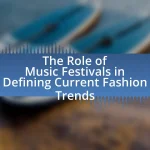The article explores the intersection of virtual reality (VR) and pop culture, highlighting how VR technology is integrated into mainstream entertainment and influences audience engagement. It examines the impact of VR on pop culture trends, notable examples in movies and television, and the ways video games utilize VR to enhance storytelling. Additionally, the article discusses the significance of VR in transforming live events, the challenges and opportunities it presents, and best practices for creators and consumers to maximize their experiences. Key components such as immersive storytelling, interactive experiences, and social connectivity are also analyzed, illustrating VR’s role in reshaping contemporary cultural consumption.
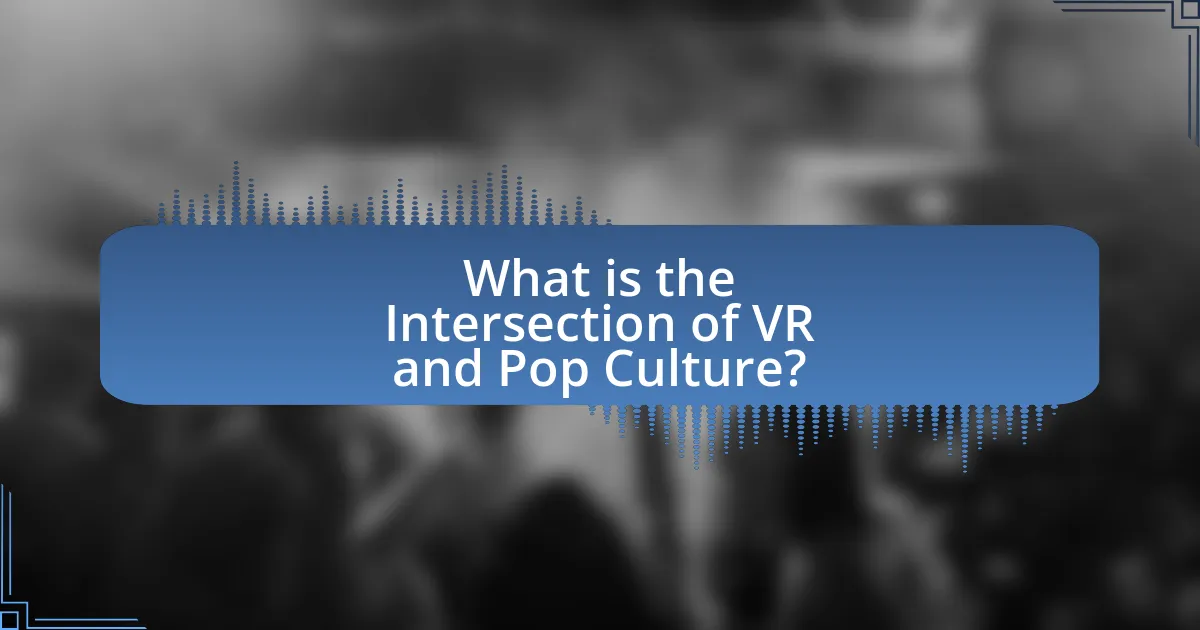
What is the Intersection of VR and Pop Culture?
The intersection of VR and pop culture is characterized by the integration of virtual reality technology into mainstream entertainment, influencing how audiences engage with media. This relationship is evident in various forms, such as immersive gaming experiences, virtual concerts, and interactive storytelling in films. For instance, popular franchises like “Star Wars” and “Marvel” have developed VR experiences that allow fans to step into their favorite universes, enhancing emotional connections and engagement. Additionally, the rise of platforms like Oculus and PlayStation VR has made VR more accessible, leading to a surge in content that reflects current cultural trends and societal themes. This synergy not only shapes consumer behavior but also drives innovation in content creation, making VR a significant player in the evolution of pop culture.
How has VR technology influenced pop culture trends?
VR technology has significantly influenced pop culture trends by enhancing immersive experiences in entertainment, gaming, and social interactions. For instance, popular franchises like “Star Wars” and “Harry Potter” have embraced VR to create engaging experiences that allow fans to interact with their favorite universes, as seen in VR games like “Star Wars: Squadrons” and “Harry Potter: Wizards Unite.” Additionally, VR has transformed live events, with platforms like Oculus Venues enabling users to attend concerts and sports events virtually, thus reshaping how audiences engage with entertainment. The rise of VR content creators on platforms like YouTube and Twitch further illustrates its impact, as these creators attract millions of viewers, showcasing VR’s role in shaping modern media consumption.
What are some notable examples of VR in movies and television?
Notable examples of VR in movies and television include “The Matrix,” where characters experience a simulated reality, and “Ready Player One,” which showcases a fully immersive virtual world. In television, “Black Mirror” features the episode “USS Callister,” which explores VR gaming and its ethical implications. These examples illustrate how VR technology is integrated into narratives, reflecting societal themes and the potential consequences of virtual experiences.
How do video games utilize VR to enhance storytelling?
Video games utilize virtual reality (VR) to enhance storytelling by immersing players in interactive environments that allow for deeper emotional engagement and agency within the narrative. This immersive experience enables players to explore story elements from a first-person perspective, creating a sense of presence that traditional gaming cannot achieve. For instance, games like “Half-Life: Alyx” leverage VR to allow players to physically interact with the environment, making choices that directly influence the storyline and character development. Research indicates that immersive storytelling in VR can lead to increased empathy and emotional connection, as players feel as though they are part of the story rather than mere observers.
Why is the integration of VR significant for pop culture?
The integration of VR is significant for pop culture because it transforms how audiences engage with media and entertainment. By providing immersive experiences, VR allows users to interact with narratives and environments in ways that traditional media cannot, enhancing emotional connections and engagement. For instance, VR experiences related to popular films or video games have been shown to increase viewer investment, as evidenced by the success of VR adaptations of franchises like “Star Wars” and “Harry Potter,” which have attracted millions of users and generated substantial revenue. This shift not only influences consumer behavior but also encourages creators to innovate, leading to new storytelling techniques and interactive formats that redefine cultural consumption.
What impact does VR have on audience engagement?
Virtual reality (VR) significantly enhances audience engagement by creating immersive experiences that captivate users’ attention. This heightened engagement occurs because VR allows audiences to interact with content in a three-dimensional space, fostering a sense of presence and emotional connection. Research indicates that VR experiences can increase retention rates by up to 70% compared to traditional media, as users are more likely to remember and engage with content that they actively participate in. Furthermore, a study published in the Journal of Computer-Mediated Communication found that VR environments can lead to stronger emotional responses, which further solidifies audience involvement and investment in the narrative.
How does VR change the way we experience live events?
VR transforms the experience of live events by immersing participants in a virtual environment that replicates or enhances the physical setting. This technology allows users to attend concerts, sports games, or theater performances from anywhere in the world, providing a sense of presence and engagement that traditional viewing methods cannot match. For instance, a study by PwC found that 43% of consumers are interested in attending live events in VR, highlighting its growing appeal. Additionally, VR can offer unique perspectives, such as 360-degree views of performances, enabling audiences to experience events from angles that would be impossible in a physical venue.
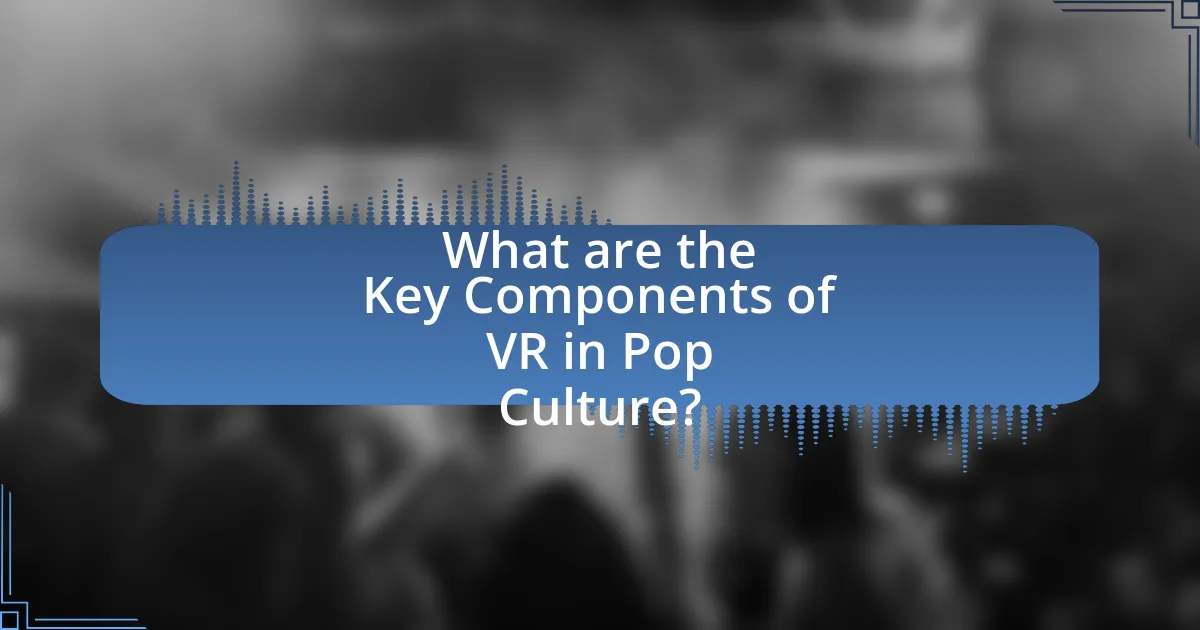
What are the Key Components of VR in Pop Culture?
The key components of VR in pop culture include immersive storytelling, interactive experiences, and social connectivity. Immersive storytelling allows users to engage deeply with narratives, as seen in VR films like “The Invisible Man” and experiences like “The Walking Dead: Saints & Sinners.” Interactive experiences enable users to participate actively, exemplified by games such as “Beat Saber” and “Half-Life: Alyx,” which have garnered critical acclaim and commercial success. Social connectivity is facilitated through platforms like VRChat and Rec Room, where users can interact in virtual environments, reflecting the growing trend of social VR experiences. These components collectively illustrate how VR is reshaping entertainment and social interaction in contemporary culture.
What types of VR experiences are popular in pop culture?
Popular types of VR experiences in pop culture include immersive gaming, virtual concerts, and social VR platforms. Immersive gaming experiences, such as “Beat Saber” and “Half-Life: Alyx,” have gained significant traction, allowing players to engage in interactive environments. Virtual concerts, exemplified by events like Travis Scott’s performance in “Fortnite,” showcase how VR can create shared experiences for audiences. Additionally, social VR platforms like “VRChat” and “Rec Room” enable users to interact and socialize in virtual spaces, reflecting a growing trend in community engagement through VR. These experiences highlight the versatility of VR in entertainment and social interaction, making it a prominent aspect of contemporary pop culture.
How do immersive experiences differ from traditional media?
Immersive experiences differ from traditional media primarily in their ability to engage users interactively and create a sense of presence. Unlike traditional media, which typically involves passive consumption of content, immersive experiences, such as virtual reality (VR), allow users to actively participate and influence the narrative. This interactivity enhances emotional engagement and personal connection, as evidenced by studies showing that VR can increase empathy and retention of information compared to conventional media formats. For instance, research published in the journal “Computers in Human Behavior” indicates that participants in VR environments reported higher levels of emotional involvement and memory recall than those exposed to traditional video content.
What role do social VR platforms play in pop culture?
Social VR platforms significantly influence pop culture by providing immersive environments for social interaction, entertainment, and creative expression. These platforms, such as VRChat and Rec Room, enable users to engage in shared experiences, participate in virtual events, and create user-generated content, which fosters community and cultural exchange. For instance, the rise of virtual concerts and events, like Travis Scott’s performance in Fortnite, illustrates how social VR can blend music and gaming, reaching millions and shaping contemporary cultural trends. Additionally, social VR platforms serve as a space for diverse representation, allowing users from various backgrounds to connect and share their narratives, further enriching the cultural landscape.
How do creators leverage VR to enhance narratives?
Creators leverage VR to enhance narratives by immersing audiences in interactive environments that foster emotional engagement and personal connection to the story. This technology allows for a first-person perspective, enabling users to experience events as if they are part of the narrative, which can deepen their emotional investment. For instance, VR experiences like “The Walking Dead: Saints & Sinners” allow players to make choices that affect the storyline, demonstrating how interactivity can influence narrative outcomes. Additionally, studies have shown that VR can evoke stronger emotional responses compared to traditional media, as evidenced by research from the University of Southern California, which found that participants experienced heightened empathy and emotional engagement when immersed in VR storytelling.
What techniques are used to create compelling VR content?
Compelling VR content is created using techniques such as immersive storytelling, interactive design, and spatial audio. Immersive storytelling engages users by placing them in the narrative, allowing them to experience events from a first-person perspective, which enhances emotional connection. Interactive design incorporates user choices, enabling personalized experiences that adapt to individual actions, thereby increasing engagement. Spatial audio enhances realism by simulating sound from various directions, creating a more believable environment. These techniques are supported by research indicating that immersive experiences can significantly enhance user engagement and retention, as demonstrated in studies by the University of Southern California’s Institute for Creative Technologies, which found that VR can increase empathy and emotional involvement in narratives.
How does user interaction shape VR storytelling?
User interaction significantly shapes VR storytelling by allowing participants to influence narrative outcomes and character development. In virtual reality, users engage with the environment and make choices that directly affect the storyline, creating a personalized experience. For instance, research by the University of Southern California highlights that interactive elements in VR can lead to deeper emotional connections with characters, as users feel their decisions have real consequences. This interactivity transforms passive viewers into active participants, enhancing immersion and engagement in the narrative.
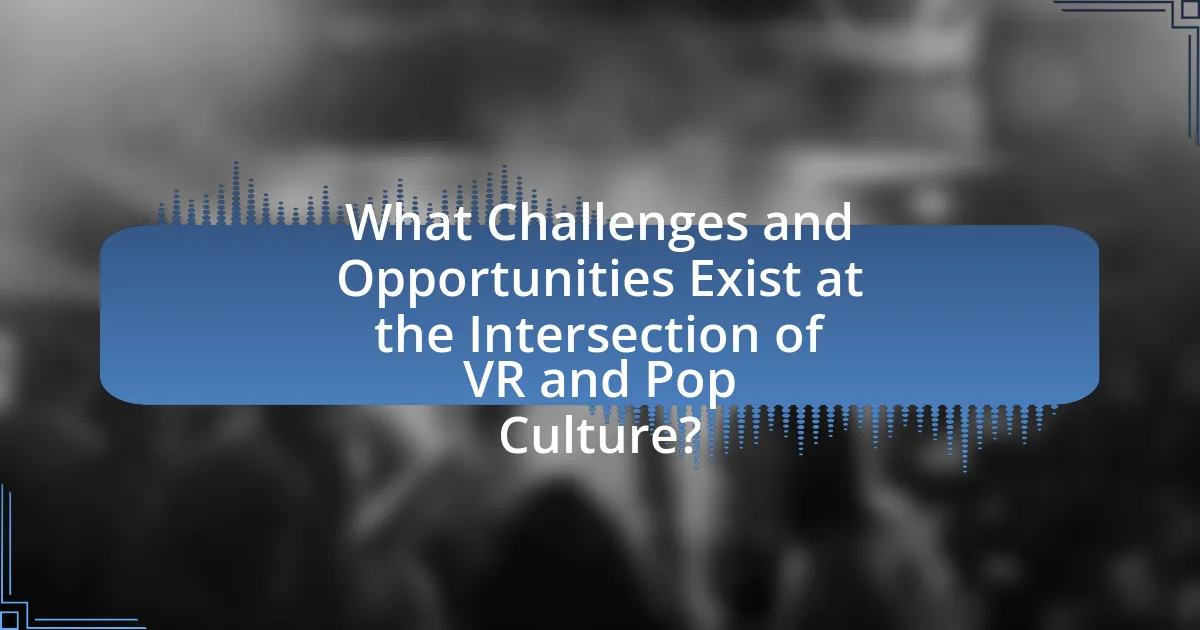
What Challenges and Opportunities Exist at the Intersection of VR and Pop Culture?
The intersection of virtual reality (VR) and pop culture presents both significant challenges and unique opportunities. One major challenge is the high cost of VR technology, which can limit accessibility for creators and consumers, thereby hindering widespread adoption in pop culture. For instance, the average price of a VR headset can exceed $300, making it a barrier for many potential users.
Conversely, the opportunity lies in the immersive experiences that VR can offer, allowing fans to engage with their favorite franchises in unprecedented ways. For example, VR experiences based on popular films or video games can enhance fan engagement, as seen with experiences like “Star Wars: Secrets of the Empire,” which allows users to step into the Star Wars universe.
Additionally, the rapid evolution of VR technology creates a dynamic environment for innovation in storytelling and content creation, enabling creators to explore new narrative forms that resonate with audiences. This duality of challenges and opportunities shapes the ongoing dialogue about the role of VR in shaping pop culture.
What are the main challenges facing VR adoption in pop culture?
The main challenges facing VR adoption in pop culture include high costs, limited content availability, and technological barriers. High costs associated with VR hardware and software can deter potential users; for instance, premium VR headsets can exceed $1,000, making them inaccessible for many consumers. Limited content availability restricts user engagement, as popular franchises may not have sufficient VR adaptations, leading to a lack of interest. Additionally, technological barriers such as the need for powerful computers and the complexity of setup can discourage casual users from adopting VR experiences. These factors collectively hinder the widespread acceptance of VR in mainstream pop culture.
How do technical limitations affect VR content creation?
Technical limitations significantly hinder VR content creation by restricting the quality and complexity of experiences developers can produce. For instance, hardware constraints such as limited processing power and insufficient graphics capabilities can lead to lower resolution visuals and reduced frame rates, which negatively impact user immersion and experience. According to a study by the International Journal of Human-Computer Interaction, VR experiences that operate below 90 frames per second can cause motion sickness and discomfort, thereby limiting the audience’s engagement. Additionally, software limitations, such as inadequate development tools and lack of standardized platforms, can complicate the creation process, making it difficult for developers to innovate and deliver high-quality content. These technical barriers ultimately shape the scope and effectiveness of VR applications in pop culture, influencing how audiences interact with and perceive virtual environments.
What are the barriers to entry for consumers?
Barriers to entry for consumers in the context of virtual reality (VR) and pop culture include high costs, lack of accessibility, and limited content availability. High costs are a significant barrier, as VR headsets and compatible hardware can range from several hundred to over a thousand dollars, making it financially prohibitive for many potential users. Accessibility issues arise from the need for adequate physical space and technical knowledge to set up and use VR systems effectively. Additionally, limited content availability restricts consumer interest; if there are not enough engaging VR experiences tied to popular culture, consumers may be less inclined to invest in the technology. These barriers collectively hinder widespread adoption of VR among consumers.
What opportunities does VR present for future pop culture developments?
VR presents significant opportunities for future pop culture developments by enabling immersive storytelling and interactive experiences. This technology allows creators to engage audiences in ways traditional media cannot, such as through virtual concerts, interactive films, and immersive gaming environments. For instance, platforms like Oculus Venues have hosted live events where users can attend concerts in a virtual space, enhancing social interaction and engagement. Additionally, VR can facilitate new forms of artistic expression, as seen in projects like “The Night Cafe,” which transforms Vincent van Gogh’s paintings into a navigable 3D environment, allowing users to explore art in a novel way. These advancements indicate that VR will play a crucial role in shaping how pop culture is experienced and consumed in the future.
How can VR be used to create new forms of entertainment?
VR can be used to create new forms of entertainment by immersing users in interactive environments that enhance storytelling and engagement. This technology allows for experiences such as virtual concerts, where users can attend live performances from anywhere in the world, and immersive gaming, where players can physically interact with the game world. For instance, platforms like Oculus Venues host live events, enabling users to experience concerts in a shared virtual space, which has been shown to increase user engagement and satisfaction. Additionally, VR can facilitate social interactions in virtual worlds, as seen in platforms like VRChat, where users create and explore diverse environments together, fostering community and collaboration.
What potential does VR have for educational and cultural experiences?
Virtual Reality (VR) has significant potential for enhancing educational and cultural experiences by providing immersive, interactive environments that facilitate deeper engagement and understanding. VR enables learners to explore historical events, scientific concepts, and cultural practices in a way that traditional methods cannot achieve. For instance, a study by the University of Maryland found that students who used VR for learning retained information better than those who learned through conventional means, demonstrating a 30% increase in knowledge retention. Additionally, VR can simulate real-world scenarios, allowing users to practice skills in a safe environment, such as medical training or language immersion. This technology also fosters cultural appreciation by allowing users to experience diverse cultures firsthand, such as virtual tours of museums or historical sites, thereby promoting empathy and global awareness.
What are some best practices for engaging with VR in pop culture?
Best practices for engaging with VR in pop culture include creating immersive experiences that leverage storytelling, ensuring accessibility for diverse audiences, and fostering community interaction. Immersive storytelling captivates users, as seen in successful VR experiences like “The Walking Dead: Saints & Sinners,” which combines narrative depth with interactive gameplay. Accessibility is crucial; for instance, platforms like Oculus Quest have made VR more available to a broader audience by offering standalone devices that do not require high-end PCs. Community interaction enhances engagement, as demonstrated by VRChat, where users create and share content, fostering a vibrant social environment. These practices collectively enhance user experience and promote sustained interest in VR within pop culture.
How can creators effectively reach their audience through VR?
Creators can effectively reach their audience through VR by designing immersive experiences that engage users emotionally and socially. By leveraging interactive storytelling and user-generated content, creators can foster a sense of presence and community, which enhances audience connection. Research indicates that immersive environments can increase user engagement by up to 70%, as users feel more involved in the narrative. Additionally, utilizing social VR platforms allows creators to host live events and experiences, facilitating real-time interaction and feedback, which further strengthens audience relationships.
What tips can consumers follow to enhance their VR experiences?
To enhance their VR experiences, consumers should ensure a well-lit and spacious play area. A clear space allows for safe movement and reduces the risk of accidents, which is crucial for immersive experiences. Additionally, using high-quality headphones can significantly improve audio immersion, as sound plays a vital role in VR environments. Furthermore, regularly updating VR software and hardware ensures access to the latest features and optimizations, enhancing overall performance. Engaging with VR communities can also provide valuable insights and tips, enriching the user experience through shared knowledge.
